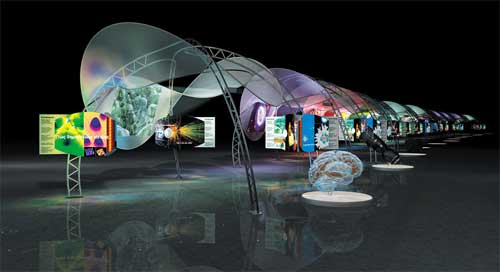| Posted: March 7, 2007 |
Nanotechnology part of European cutting-edge research exhibition |
|
(Nanowerk News) Immerse yourself in the world of the latest research developments - a walk through the Science Tunnel presented by the Max Planck Society makes it possible. The multimedia exhibition will be officially opened on March 7, 2007 in Brussels under the motto "Be amazed!"
|
|
For ten days (March 8 to 18), visitors will be able to undertake a fascinating discovery of present-day and future scientific innovations. The exhibition will then move to Johannesburg, South Africa. The exhibition is being promoted in the 'Maison du Bois' exhibition hall in Brussels by the European Commission together with the German Federal Ministry of Education and Research. BASF, the TRUMPF group and the Berthold Leibinger foundation are contributing to the exhibition.
|
 |
| The 'Science Tunnel' - immerse yourself in the world of science: The Max Planck Society invites you to take a stroll through the exhibition of the latest research topics in the 'Maison du Bois', Avenue des Volontaires, 2, 1040 Brussels. (Image: Max Planck Society)
|
|
"The 'Science Tunnel’ impresses on visitors the excitement and appeal of making new discoveries in previously uncharted territories. Our main intention with this exhibition is to inspire young people. The future can only be ours by carrying out world-class research and for that, we need the youth of today - who are the scientists of tomorrow," says Prof. Dr. Peter Gruss, President of the Max Planck Society.
|
|
"We want to inspire visitors with interesting examples from BASF’s pioneering research," explains Dr. Stefan Marcinowski, member of BASF’s Board of Executive Directors and Research Executive Director. "We are presenting our innovations for the more efficient use of energy, such as organic light diodes as an energy-saving form of light or nano-foams to improve heat insulation. With plant biotechnology, we are improving the supply of raw materials to industry, for example with our Amflora potato, which provides starch for the paper industry."
|
|
In the 'Science Tunnel', visitors can "peer" over the shoulders of researchers: The exhibition, covering an area of approximately one thousand square metres in a darkened room, contains images, video projections, computer simulations and exhibits from current research projects, providing interesting insights into the hidden world of the micro- and macrocosmos.
|
|
The spectrum extends from the search for the smallest particle to research into the basics of life and thought through to capturing the largest structures in the universe. Multimedia technology coupled with innovative exhibits show the status of today's state-of-the-art research in Europe and the world, which new topics are leading the way in research, how the different scientific fields are related to one another and how they will affect our lives in the future. The exhibits include major scientific breakthroughs in important areas of research in life sciences and biosciences. The majority of these unique images, videos and artefacts originate from the 78 Max Planck institutes. CERN, the world's largest laboratory for particle physics, the European Space Agency (ESA), the European Southern Observatory (ESO), the Fraunhofer Gesellschaft and other organizations have also made important loans to the exhibition.
|
|
One of the themes of the exhibition is titled "Nano Cosmos" and it deals with nanosciences and nanotechnologies. It shows examples of nanotechnology in for instance materials sciences and energy storage. There are also nanotechnology related pictures and movies in this section.
|

